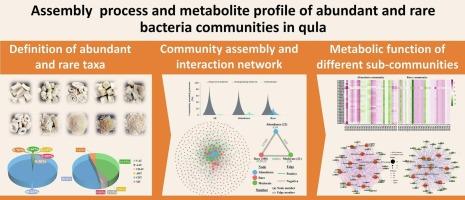Exploring the rare and abundant bacterial community structures and their metabolic differences in various types of qula cheese
IF 8
1区 农林科学
Q1 FOOD SCIENCE & TECHNOLOGY
引用次数: 0
Abstract
Qula is a fermented cheese-like product made from yak milk. Although the bacterial communities in qula have been well documented, the diversity and functions of both abundant and rare bacterial subcommunities are still unclear. Here, our study examines the community structures of abundant and rare taxa, as well as their metabolite profiles, in the distinct qula samples from Tibet, China, employing high-throughput sequencing and untargeted metabolomics. Our results indicate that rare bacterial taxa account for 98.15 % of total operational taxonomic units and 48 % of total sequences. Dominant bacteria from abundant taxa consist of Lactococcus, Lactobacillus, and Acetobacter, while rare taxa contain Prevotella, Ruminococcus, and Butyrivibrio. Furthermore, we show that stochastic processes predominantly influence bacterial assembly in qula microbial communities. Specifically, stochastic processes have a more significant impact on community assembly for rare taxa, while deterministic processes are more important for abundant taxa. Moreover, we evaluate the contributions of rare taxa to network complexity and community stability, identifying potential keystone species. By analyzing metabolic profiles, we further compared the differences in metabolic functions between rare and abundant taxa in the qula microbiome. Our study shows that, along with abundant taxa, rare taxa in the qula microbiome play a significant role in community assembly and interactions, offering valuable insights into the microbial ecosystems of traditional fermented foods.

探索不同类型库拉奶酪中罕见和丰富的细菌群落结构及其代谢差异
库拉是一种由牦牛奶制成的发酵奶酪状产品。虽然库拉湖中的细菌群落已经被很好地记录下来,但丰富的和罕见的细菌亚群落的多样性和功能仍然不清楚。结果表明,稀有细菌类群占总操作分类单位的98.15%,占总序列的48%。在丰富的分类群中,优势菌群包括乳球菌、乳杆菌和醋酸杆菌,而在少数分类群中则有普氏菌、瘤胃球菌和丁酸弧菌。此外,我们表明随机过程主要影响库拉微生物群落中的细菌组装。其中,随机过程对稀有分类群的群落聚集影响更大,而确定性过程对丰富分类群的群落聚集影响更大。此外,我们还评估了稀有类群对网络复杂性和群落稳定性的贡献,并确定了潜在的关键物种。通过分析代谢谱,我们进一步比较了库拉菌群中稀有和丰富类群的代谢功能差异。我们的研究表明,除了丰富的类群外,库拉菌群中的稀有类群在群落组装和相互作用中起着重要作用,为传统发酵食品的微生物生态系统提供了有价值的见解。
本文章由计算机程序翻译,如有差异,请以英文原文为准。
求助全文
约1分钟内获得全文
求助全文
来源期刊

Food Research International
工程技术-食品科技
CiteScore
12.50
自引率
7.40%
发文量
1183
审稿时长
79 days
期刊介绍:
Food Research International serves as a rapid dissemination platform for significant and impactful research in food science, technology, engineering, and nutrition. The journal focuses on publishing novel, high-quality, and high-impact review papers, original research papers, and letters to the editors across various disciplines in the science and technology of food. Additionally, it follows a policy of publishing special issues on topical and emergent subjects in food research or related areas. Selected, peer-reviewed papers from scientific meetings, workshops, and conferences on the science, technology, and engineering of foods are also featured in special issues.
 求助内容:
求助内容: 应助结果提醒方式:
应助结果提醒方式:


